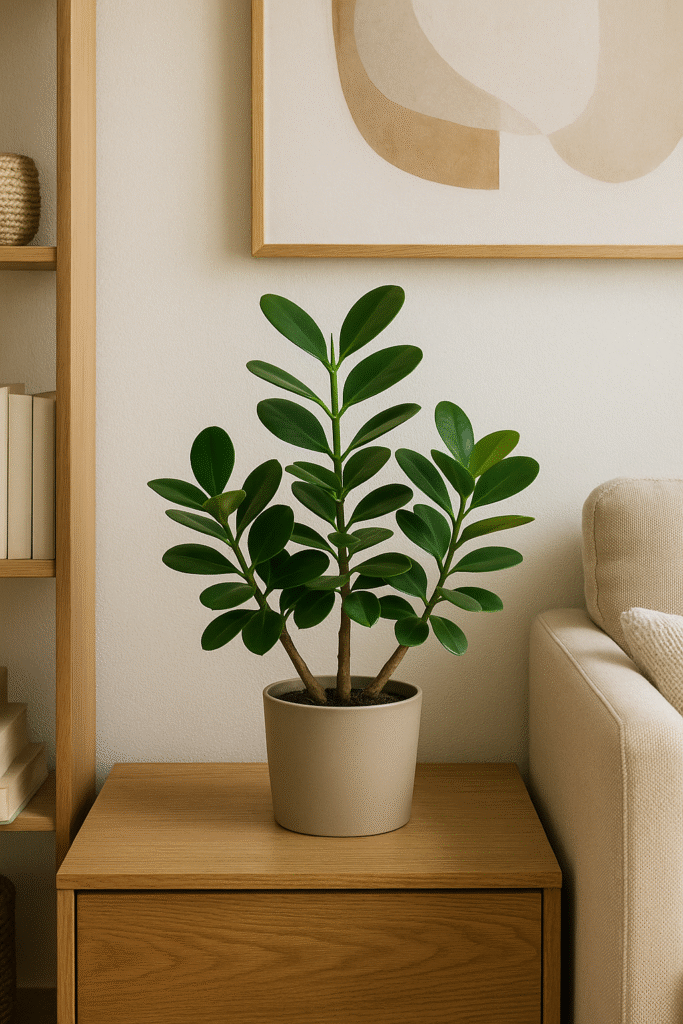Clusia, also known as Clusia rosea or the “Autograph Tree,” is a striking ornamental plant that has gained popularity in homes and gardens worldwide. Native to the tropical regions of the Americas, Clusia is known for its bold, glossy foliage, resistance to pests, and ability to thrive both outdoors and indoors. In this guide, you’ll discover everything you need to know about Clusia: its origin, benefits, care instructions, and why it’s become a favorite in modern home decor.
Origin and Characteristics of Clusia
Clusia belongs to the Clusiaceae family and is originally found in the Caribbean, Central, and South America. In Brazil, it often grows in coastal regions and tropical forests. The most well-known species is Clusia rosea, admired for its thick, leathery leaves and symmetrical shape.
The plant’s dark green, oval-shaped leaves are thick and shiny, giving it a lush, tropical appearance. Clusia can be grown as a small tree, shrub, or potted houseplant. In the right conditions, it may even produce delicate, star-shaped flowers—typically pink or white—adding to its ornamental value.
One unique feature of Clusia rosea is that people often “sign” their names on its thick leaves—hence the nickname Autograph Tree.
Why Clusia is a Landscape Favorite
Clusia is a top choice for landscape designers and indoor plant lovers alike for many reasons:
-
✅ Easy to shape: It responds well to pruning and can be shaped as a bush, tree, or even hedge.
-
✅ Sun and wind tolerant: Perfect for outdoor use in tropical and coastal environments.
-
✅ Adaptable to partial shade: Can also thrive indoors near bright windows.
-
✅ Low maintenance: Requires minimal watering and fertilization.
-
✅ Modern appeal: Its clean, bold leaf structure pairs beautifully with contemporary decor.
This balance of ruggedness and elegance makes Clusia ideal for both modern apartments and tropical gardens.
Clusia Care Guide: How to Keep It Thriving
Although it’s a hardy plant, Clusia still benefits from basic care. Here are the key aspects to focus on:
1. Light Requirements
Clusia thrives in bright, indirect light but can tolerate full sun when grown outdoors. Indoors, place it near large windows, balconies, or use LED grow lights to ensure proper growth.
2. Watering
Water Clusia when the top inch of soil feels dry. Avoid overwatering to prevent root rot. In summer, you may water 2–3 times per week; in winter, once a week or less may suffice.
3. Soil and Potting
Use well-draining soil, ideally a mix of potting soil, sand, and compost. The pot must have drainage holes to avoid standing water.
4. Pruning
Prune Clusia regularly to maintain its shape and encourage bushier growth. Always cut above a leaf node using sterilized pruning shears.
5. Fertilization
Fertilize every 2 months using a balanced fertilizer (such as NPK 10-10-10). During spring and summer, your Clusia will grow faster and may require more nutrients.
6. Pests and Problems
Clusia is generally pest-resistant, but keep an eye out for mealybugs or scale insects, especially if overwatered. Clean leaves occasionally and use neem oil or insecticidal soap if needed.
Clusia as an Indoor Plant: Stylish and Easygoing
Clusia’s symmetrical growth and bold foliage make it perfect for modern interior design. It fits beautifully into:
-
Minimalist apartments
-
Scandinavian-style living rooms
-
Tropical-themed balconies
-
Home offices and entryways
Pair it with ceramic or terracotta pots for a chic look. If you lack natural light, LED grow lights are a great way to ensure your Clusia continues to thrive and produce lush leaves year-round.
Propagating Clusia at Home
Want more Clusias without buying new ones? Clusia can be easily propagated via stem cuttings. Here’s how:
-
Cut a 15 cm (6-inch) healthy stem.
-
Remove the lower leaves and place the cutting in water or moist soil.
-
Keep in a warm, bright spot (no direct sun).
-
Roots usually develop within 3–4 weeks.
Once rooted, transfer the cutting to a permanent pot and continue normal care.
Extra Tips for Success
-
Keep Clusia away from freezing temperatures (below 50°F / 10°C).
-
Wipe the leaves with a damp cloth twice a month to remove dust and help with photosynthesis.
-
If your plant seems stagnant, consider repotting it with fresh soil.

🌱 Support Your Clusia’s Growth with the Right Light!
If you’re growing Clusia indoors or in a low-light area, providing the right supplemental light is key. Try these:
👉 [LED Grow Lights for Plants (2-Pack)]
Full-spectrum grow lights with red, blue, and white light, perfect for houseplants and seedlings. Features include:
-
✅ Dual heads
-
✅ 10 brightness levels
-
✅ Automatic timer
-
✅ Flexible arms and easy clip-on design
These lights will keep your Clusia vibrant and healthy—even in shaded indoor spaces.
🌳 Discover the Golden Healing Power of Copaíba!
If you’re passionate about natural wellness, you’ll love learning about Copaíba, the Amazonian tree known for its anti-inflammatory, antibacterial, and healing properties. From traditional uses by native communities to modern essential oil extraction, this tree is a true gift from nature.

